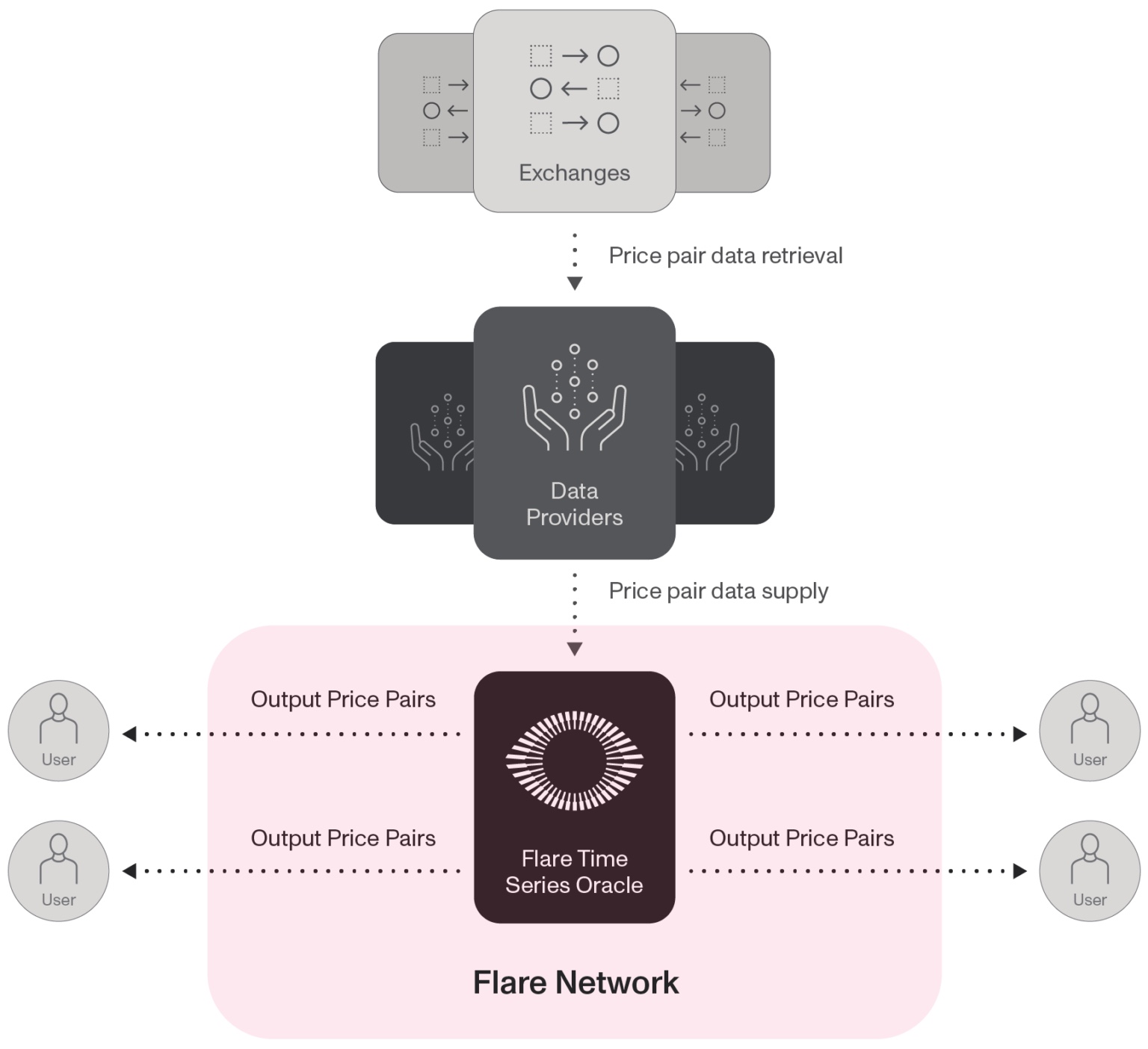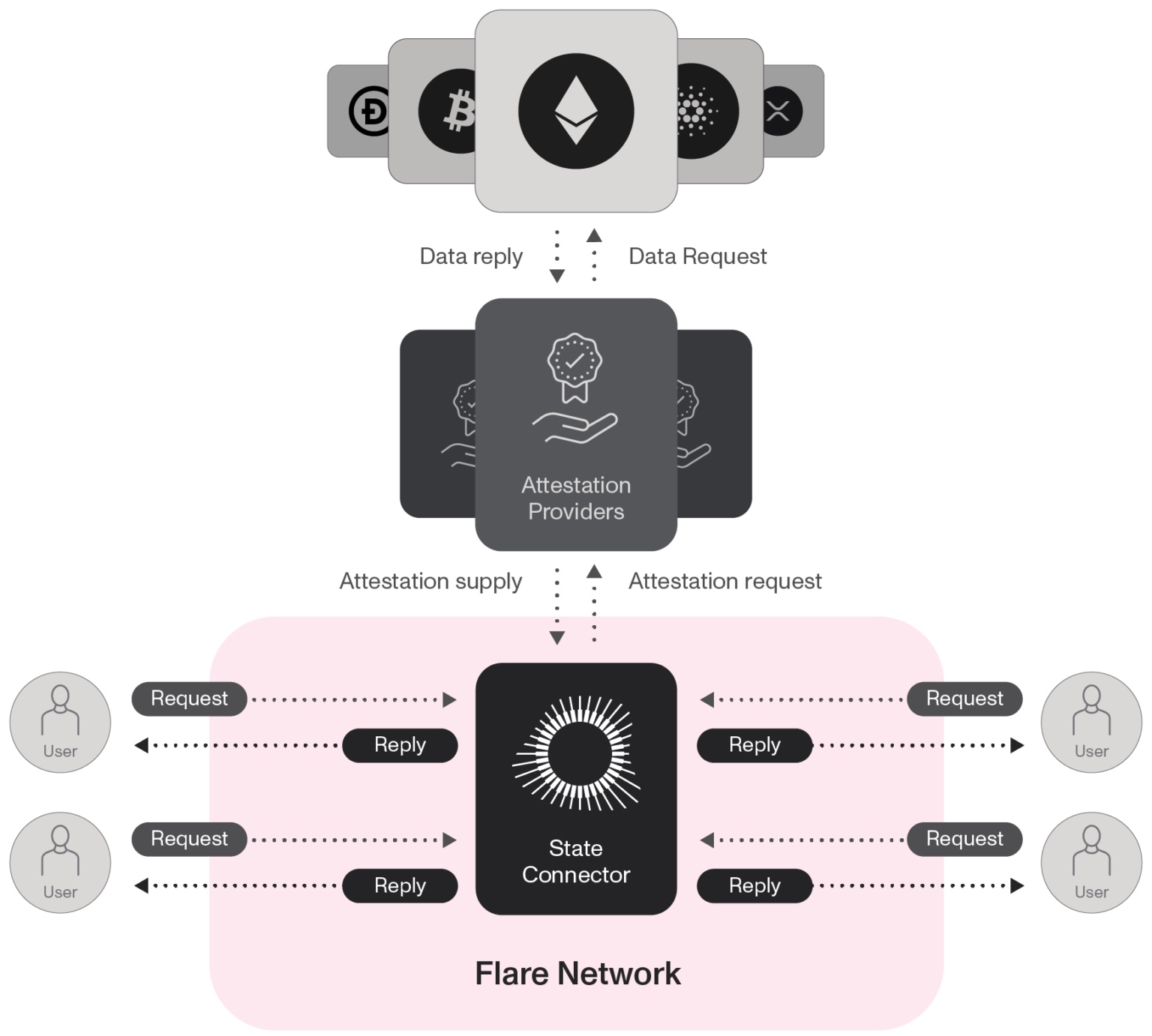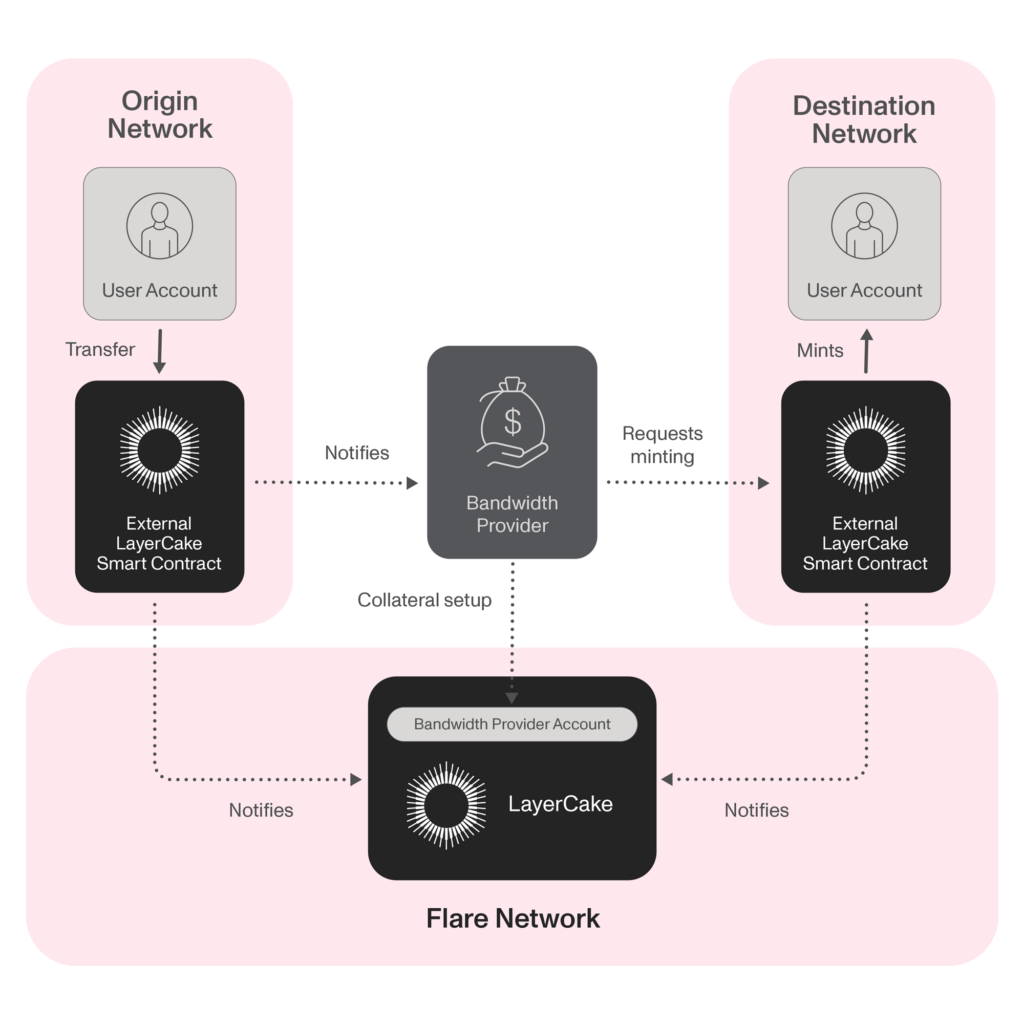Flare 101
Flare 101
Flare is the blockchain for data.
It is a Layer 1 like Ethereum, with added data acquisition functionality. Flare can therefore offer developers decentralized access to high-integrity data from other chains and the internet. This enables the creation of dapps with new use cases and monetization models. It also allows these dapps to serve multiple chains through a single deployment.
Flare is Ethereum Virtual Machine (EVM) based, meaning any applications written in Solidity to run on any other EVM chain can also be used on Flare.
Flare is the blockchain for data.
It is a Layer 1 like Ethereum, with added data acquisition functionality. Flare can therefore offer developers decentralized access to high-integrity data from other chains and the internet. This enables the creation of dapps with new use cases and monetization models. It also allows these dapps to serve multiple chains through a single deployment.
Flare is Ethereum Virtual Machine (EVM) based, meaning any applications written in Solidity to run on any other EVM chain can also be used on Flare.
Flare is the blockchain for data.
It is a Layer 1 like Ethereum, with added data acquisition functionality. Flare can therefore offer developers decentralized access to high-integrity data from other chains and the internet. This enables the creation of dapps with new use cases and monetization models. It also allows these dapps to serve multiple chains through a single deployment.
Flare is Ethereum Virtual Machine (EVM) based, meaning any applications written in Solidity to run on any other EVM chain can also be used on Flare.

The FTSO is a highly-decentralized protocol for safely retrieving external time series data for use on Flare, such as digital asset price pairs. It takes data at predetermined intervals (currently 3 minutes) from an independent network of data providers, which are incentivized to deliver accurate data.
The FTSO system computes an estimate for each time series and makes it available for any user or application to request. This data can be used for any number of use cases, such as asset prices in a decentralized lending protocol.
Approximately 100 independent data providers are incentivized by the network to deliver this information accurately. The rewards that each data provider receives for successful provision of decentralized data are then shared with all token holders that have delegated to them.
The website FlareMetrics.io provides statistics on the performance of all of the network’s data providers.

The FTSO is a highly-decentralized protocol for safely retrieving external time series data for use on Flare, such as digital asset price pairs. It takes data at predetermined intervals (currently 3 minutes) from an independent network of data providers, which are incentivized to deliver accurate data.
The FTSO system computes an estimate for each time series and makes it available for any user or application to request. This data can be used for any number of use cases, such as asset prices in a decentralized lending protocol.
Approximately 100 independent data providers are incentivized by the network to deliver this information accurately. The rewards that each data provider receives for successful provision of decentralized data are then shared with all token holders that have delegated to them.
The website FlareMetrics.io provides statistics on the performance of all of the network’s data providers.

The FAssets system, developed by Flare Labs, allows non-smart contract tokens such as XRP, BTC and DOGE to be used trustlessly within smart contracts on Flare.
The FAssets system is enabled by Flare’s data acquisition protocols, the State Connector and Flare Time Series Oracle. The FTSO provides decentralised price feeds for all the tokens involved, and the State Connector can verify that a required action has taken place on a different chain.
Each FAsset will be backed by mixed on-chain collateral held by an agent and in a community provided pool. This backing consists of three asset types: the underlying, stablecoin or ETH collateral, and Flare native token collateral, FLR or SGB. The minting and redeeming process will be supported by a number of agents. Their role in the system is secured through over-collateralization, such that the system is rendered trustless.
Someone who wishes to mint FAssets starts by selecting an agent and paying a small fee to reserve the required collateral. The minter then sends the agent the underlying asset, with the State Connector used to prove the transaction has taken place on the other chain. With the payment verified, the FAssets are then minted as ERC-20 tokens on Flare. These tokens can be used within DeFi on Flare or bridged to another chain.

LayerCake, in development by Flare Labs, is a decentralized insured-in-transit bridging and cross-network composability protocol. It offers increased security, speed, scalability and functionality of bridging between different smart contract networks.
Every transfer in LayerCake is insured-in-transit with 1-to-1 backing by the actual asset being transferred. Using collateral in this way allows for lowest latency trustless bridging, while providing insurance against faulty operator behavior as well as blockchain reorgs that happen to a certain depth, e.g. 6 hours.
Once the crossing is complete and the wrapped asset is in the user’s account, the collateral is unlocked after a short period of time, ready to be used in another crossing. For this reason this collateral is termed “bandwidth”, because it dictates how much value can move across the bridge at any one time. Its existence renders LayerCake trustless, with no multisig, no governance role, nor any trusted party in the system.
The bandwidth collateral securing bridging comes from the bridge’s operators, who are called bandwidth providers. They take a small fee from each transaction. Bandwidth providers cannot secure a bridge crossing for a value higher than the amount of collateral they have locked.
The value that can cross the bridge at any one time is dictated by the total bandwidth held by the bridge. Like physical bridges, LayerCake bridges can handle any amount of “traffic” flowing across them over time. They only restrict the amount of traffic that can transit simultaneously.
To avoid fragmenting liquidity, LayerCake is multilateral. This means you can bridge a token, for instance wrapped ETH, from multiple origin chains to a single destination chain and receive the same token representation regardless of where it came from.
Delegation is the temporary assignment of your FLR or SGB tokens to Flare Time Series Oracle data providers to support the delivery of decentralized data to the network. The tokens can be undelegated at any time, and they are not locked from being used for other purposes.
Token holders receive a share of the rewards earned by the data providers they have delegated to. The more accurate a data provider’s submissions and the larger the number of tokens delegated to them, the more rewards they receive and are able to share with their delegators. This creates a positive feedback loop incentivizing the provision of accurate data, whereby the most successful data providers will attract the most delegations.
Delegation is the temporary assignment of your FLR or SGB tokens to Flare Time Series Oracle data providers to support the delivery of decentralized data to the network. The tokens can be undelegated at any time, and they are not locked from being used for other purposes.
Token holders receive a share of the rewards earned by the data providers they have delegated to. The more accurate a data provider’s submissions and the larger the number of tokens delegated to them, the more rewards they receive and are able to share with their delegators. This creates a positive feedback loop incentivizing the provision of accurate data, whereby the most successful data providers will attract the most delegations.
FLR is the native token used for payments and transaction fees. FLR can also be wrapped into an ERC-20 variant, WFLR. WFLR tokens have additional functionality and can be delegated to FTSO data providers or used to participate in network governance. These two uses are not mutually exclusive and do not prevent the tokens from being used in other EVM-compatible dapps and smart contracts on Flare.
Tokens can be wrapped natively in Bifrost Wallet, or by connecting to the Flare Portal when using a different hardware or software wallet.
Songbird is the canary network for Flare. It is an operational blockchain with a defined token supply that allows new features or applications to be tested under production conditions before they are deployed on the main network. This is in contrast to a testnet which generally has an unlimited token supply.
Governance on Flare originates from two primary sources. First, the Flare Foundation can submit governance proposals for the Flare mainnet and Songbird canary network, which FLR and SGB token holders can vote upon. Second, future developments will implement a bicameral system where SGB token holders can submit and vote upon governance proposals for the Songbird network with the intention of them being advanced as Flare Improvement Proposals if they are successful.
Proposals are visible in the Proposals Repository and when active can be voted on using the Flare Portal.
